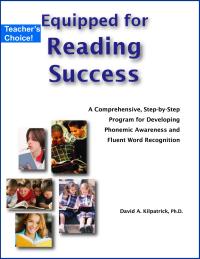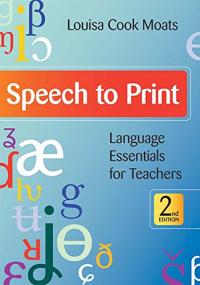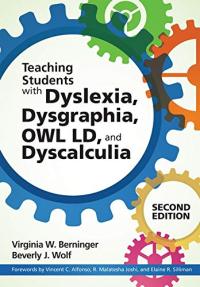Featured booklists
Themed Booklist
Teaching Reading
Themed Booklist
The Cognitive Science of Reading
Themed Booklist
Reading Motivation and Reading Aloud
Themed Booklist
Teaching Writing
Themed Booklist
Learning Differences
Themed Booklist
In the Classroom: Teaching Children on the Autism Spectrum
Themed Booklist
About Autism: Books for Parents and Educators
Adult Education Books

Written from a strengths-based perspective, the author explores the theoretical underpinnings of reading, language, and literacy and provides detailed information on the wide range of reading inventories and standardized tests that may be used in a reading assessment. With a focus on how to craft professional evaluation reports that illuminate a student’s strengths ― not just weaknesses ― that enables school psychologists and diagnosticians, reading specialists, and special education professionals to conduct evaluations and develop effective interdisciplinary remedial recommendations and interventions.
Reading Assessment: Linking Language, Literacy, and Cognition

A decade ago, Wolf’s Proust and the Squid revealed what we know about how the brain learns to read and how reading changes the way we think and feel. Since then, the ways we process written language have changed dramatically. New research on the reading brain chronicles these changes in the brains of children and adults as they learn to read while immersed in a digitally dominated medium. Drawing on this research, this book looks at concerns around attention span, critical reasoning, and over-reliance on technology ― as well as hopes about what is happening to the reading brain as it changes to adapt to digital mediums.
Reader, Come Home: The Reading Brain in a Digital World

A comprehensive, step-by-step program for developing phonemic awareness and fluent word recognition.
Equipped for Reading Success

The new edition of this bestselling text helps elementary educators grasp the structure of written and spoken English, understand how children learn to read, and apply this foundational knowledge as they deliver explicit, high-quality literacy instruction. You’ll find expanded information on the critical elements of language, including orthography, morphology, phonetics, phonology, semantics, and syntax. See also: Speech to Print Workbook: Language Exercises for Teachers, Second Edition (opens in a new window).
Speech to Print: Language Essentials for Teachers, Second Edition

How can teachers provide effective instruction for students with learning disabilities while meeting the needs of all students? The second edition of this accessible text gives K–12 educators research-based answers. The book covers all four learning disabilities that require differentiated instruction — dysgraphia, dyslexia, dyscalculia, and oral and written language learning disability. It helps prepare educators to deliver explicit and engaging instruction customized to the needs of their students. Critical insights from diverse fields blend with lessons learned from actual teaching experience, making this both a preservice text and an in-service professional development tool.
Teaching Students with Dyslexia, Dysgraphia, OWL LD, and Dyscalculia

The authors discuss the non-evidence-based interventions that proliferate in the fields of children’s speech, language, literacy, attention, cognition, working memory, and behavior. They explore the science — or lack thereof — behind the interventions and suggest evidence-based alternatives that enjoy stronger scientific support. Written in lively, readable language, the book provides clear descriptions of each intervention and the populations to whom they are marketed; reasoned explanations of why the intervention should be approached with caution or rejected outright; and suggestions for interventions with proper scientific support, suitable for the children in question.
Making Sense of Interventions for Children with Developmental Disorders: A Guide for Parents and Professionals

A multidisciplinary overview of contemporary knowledge about reading and related skills. The book provides comprehensive coverage of the subject, including theoretical approaches, reading processes, stage models of reading, cross-linguistic studies of reading, reading difficulties, the biology of reading, and reading instruction. Sections include: Word Recognition Processes in Reading; Learning to Read and Spell; Reading Comprehension; Reading in Different Languages; Disorders of Reading and Spelling; Biological Bases of Reading; and Teaching Reading.
The Science of Reading: A Handbook

The act of reading is so easily taken for granted that we forget what an astounding feat it is. How can a few black marks on white paper evoke an entire universe of meanings? It’s even more amazing when we consider that we read using a primate brain that evolved to serve an entirely different purpose. In this book, neuroscientist Stanislas Dehaene, author of How We Learn, explores every aspect of this human invention, from its origins to its neural underpinnings. A world authority on the subject, Dehaene reveals the hidden logic of spelling, describes pioneering research on how we process languages, and takes us into a new appreciation of the brain and its wondrous capacity to adapt.
Reading in the Brain: The New Science of How We Read

A practical, accessible, in-depth guide to reading assessment and intervention. It provides a detailed discussion of the nature and causes of reading difficulties, which will help develop the knowledge and confidence needed to accurately assess why a student is struggling. Readers will learn a framework for organizing testing results from current assessment batteries. Case studies illustrate each of the concepts covered. A thorough discussion is provided on the assessment of phonics skills, phonological awareness, word recognition, reading fluency, and reading comprehension.
Essentials of Assessing, Preventing, and Overcoming Reading Difficulties

Cognitive neuroscientist Seidenberg digs deep into the science of reading to reveal the ways human beings learn how to read and process language. He develops a careful argument, backed by decades of research, to show that the only responsible way to teach children to read well is to build up their abilities to connect reading with speech and then to amplify these connections through practice, developing skillful behavioral patterns hand in hand with the neurological networks that undergird them.
Language at the Speed of Sight: How We Read, Why So Many Can’t, and What Can Be Done About It

Basic reading proficiency is key to success in all content areas, but attending to students’ literacy development remains a challenge for many teachers, especially after the primary grades. This book presents recommendations for the essential knowledge about the development, acquisition, and teaching of language and literacy skills that teachers need to master and use.
Knowledge to Support the Teaching of Reading

In the 1990s, Anne Meyer, David Rose, and their colleagues at CAST introduced universal design for learning (UDL), a framework to improve teaching and learning. This new look at UDL provides insights from research on learner differences, first-hand accounts and exemplars of how to implement UDL at all levels and across subjects using the UDL Guidelines, and opportunities to participate in a UDL community
Universal Design for Learning: Theory and Practice

Are you trying to grow the inclusive schooling model in your community? Do you feel like you have tried everything to create change in your school? Do you want to sharpen the saw and become reenergized as an advocate or educator? The activities, examples, and illustrations in the book are designed to help participants refine their vision and their skills when it comes to inclusion. The ideas are free or low cost, and many can be achieved by any number of stakeholders including students and families.
Don’t We Already Do Inclusion?: 100 Ideas for Improving Inclusive Schools

This book addresses the most important issues new teachers face when working with students with disabilities. Topics covered include professional expectations, collaborating with other teachers and therapists, establishing parent relationships that enhance communication, creating an effective learning environment that meets all students’ needs, managing the classroom, using technology wisely, assessing student progress, and planning successful academic instruction. The book includes reproducible pages, tip sheets, and checklists, along with a detailed resource list.
Teacher’s Survival Guide: The Inclusive Classroom

The book offers a checklist of 15 key inclusive education best practices that together comprise quality inclusive education. Each chapter details an individual best practice and provides a list of best practice indicators that deconstruct the best practice. Readers are instructed to rate the degree to which the each indicator occurs in their schools. The Inclusive Education Checklist is an important resource for helping schools, districts, administrators, policy makers, teachers, paraprofessionals and all those committed to inclusive education understand what inclusion is, where their school is on the journey to being truly inclusive, and what needs to be done to ensure continuous improvement.
The Inclusive Education Checklist: A Self-Assessment of Best Practices

Now completely updated and expanded, this guide supports teachers every step of the way in creating a classroom that is responsive to the needs of students with Autism Spectrum Disorder — while keeping your other students and yourself going strong. With 1 in 68 children currently diagnosed with ASD, this is a useful resource for K-8 teachers. Learn how unique individuals on the autistic spectrum differ in their abilities and how these differences may be incorporated in reaching them and teaching them.
Autism Spectrum Disorder in the Inclusive Classroom

An all-in-one resource that combines research-based strategies and practical tools to help you design and implement a truly inclusive education program. You’ll discover: step-by-step plans for implementing new programs; guidance on how to strengthen existing inclusive programs; strategies to empower and involve families, students with disabilities, and their peers; and tools to assess student interests and develop adaptation plans.
The Inclusion Toolbox: Strategies and Techniques for All Teachers

This user-friendly guide was created to help educators learn more about universal design by exploring the practices associated with it. The book features dozens of ideas for providing multiple methods of engagement (e.g., creating personalized learning plans, using collaborative activities, engaging in community building), multiple methods of action and expression (e.g., providing assessment choices, encouraging dialogue, introducing assistive technology), and multiple methods of representation (e.g., teaching with powerful visuals, trying new presentation software, using more than one mode of output during a lecture).
Universal Design Daily: 365 Ways to Teach, Support & Challenge All Learners

How can K–12 educators break down the barriers to full inclusion and teach all learners effectively? Get guidance on key topics like team collaboration, universal design for learning, co-teaching, social-emotional supports, and accommodations. You’ll get 40 specific, teacher-tested strategies to modify your curriculum for students who work below grade level.
Inclusion in Action: Practical Strategies to Modify Your Curriculum

With even the best curricula and interventions, students with autism spectrum disorders will not learn unless the classroom environment is organized with their specific needs in mind. In this book you’ll find clear, brief text and lots of photos how to determine what type of furniture and materials to choose for various types of classrooms and how to arrange them in a way that creates an effective learning environment while reducing anxiety and preventing problem behaviors. It uses evidence-based practices of structure and visual supports to enhance the well-being and success of students.
Setting Up Classroom Spaces That Support Students With Autism Spectrum Disorders

Individuals with ASD are supported by a variety of people throughout their day, at school, work, and home. Parents and teachers can help build independence in children with autism by using structured work systems. In this book, you’ll learn how to set up structured work systems that provide visual information about tasks, task completion, and transitions to what comes next.
Building Independence: How to Create and Use Structured Work Systems

This volume reports the findings of the National Literacy Panel on Language-Minority Children and Youth. The formal charge to the panel — a distinguished group of expert researchers in reading, language, bilingualism, research methods, and education — was to identify, assess, and synthesize research on the education of language-minority children and youth with respect to their attainment of literacy.
Developing Literacy in Second-Language Learners: Report of the National Literacy Panel on Language-Minority Children and Youth

In this narrative history of autism, you’ll learn the story of parents fighting for their children ’s civil rights; of doctors struggling to define autism; of ingenuity, self-advocacy, and profound social change. In a Different Key takes us on a journey from an era when families were shamed and children were condemned to institutions to one in which a cadre of people with autism push not simply for inclusion, but for a new understanding of autism: as difference rather than disability.
In a Different Key

This book uses photographs of students engaging in a variety of real-life social situations. The realistic format plays to the visual strengths of children with ASD to teach appropriate social behaviors. Color photographs illustrate the “right way” and “wrong way” to approach each situation and the positive/negative consequences of each. A facilitator (parent, teacher, etc.) is initially needed to explain each situation, and ask questions such as “What is happening in this picture?” Children role-play skills until confident enough to practice them in real-life interactions.







